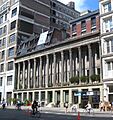Colonnade Row facts for kids
|
LaGrange Terrace
|
|

View from uptown (north)
|
|
| Location | New York, New York |
|---|---|
| Area | NoHo |
| Built | 1832 |
| Architectural style | Greek Revival |
| NRHP reference No. | 76001242 |
Quick facts for kids Significant dates |
|
| Added to NRHP | December 12, 1976 |
Colonnade Row, also known as LaGrange Terrace, is a famous row of buildings in New York City. You can find them on Lafayette Street in the NoHo neighborhood. These buildings were constructed in the early 1830s.
They are known for their Greek revival style, which means they look like ancient Greek temples. Only four of the original nine buildings are still standing today. They are protected as a landmark.
The buildings were first called LaGrange Terrace. This name came from the French estate of the Marquis de Lafayette. He was a hero of the American Revolution. A wealthy businessman named John Jacob Astor bought the land where these buildings stand. His grandson, John Jacob Astor III, later lived in one of them.
Contents
What is Colonnade Row?
The Original Design and Location
Colonnade Row originally had nine large townhouses. They were built by Seth Geer, a contractor from Albany, New York. These homes were located where the Vauxhall Gardens Amusement Park used to be.
John Jacob Astor bought this land in 1804. When the amusement park's lease ended, Astor created a wide street through the property. He named it Lafayette Place after the Marquis de Lafayette. The buildings themselves were named LaGrange Terrace, after Lafayette's country home in France. This was done after Lafayette's popular visit to the United States in 1824–25.
Building Features and Materials
Each of these grand homes had 26 rooms. They were about 27 feet (8.2 meters) wide. They also had front yards that were 15 feet (4.6 meters) deep, which was unusual for the time.
The outside of the buildings, called the facade, was made entirely of Westchester marble. This marble came from Sing Sing, where prisoners helped cut it for construction. The most striking feature was a long line of Corinthian columns connecting the homes. These columns give the buildings their current name, Colonnade Row.
Who Designed Colonnade Row?
There is some discussion about the exact year the buildings were finished and who designed them. Architects Alexander Jackson Davis, Ithiel Town, and James Dakin are often given credit. They were thought to have designed the homes for the wealthy Astor and Vanderbilt families.
Town and Dakin likely started working on the project, which they called LaGrange Terrace, in late 1831 or early 1832. The buildings were completed in 1833. It's not clear if Alexander Jackson Davis was involved in the final construction or even the design.
Famous Residents of Colonnade Row
Many important people lived on Colonnade Row. These included John Jacob Astor III, who was a grandson of the wealthy John Jacob Astor.
Julia Gardiner, who later became the First Lady when she married President John Tyler, also lived there. Other famous residents included businessman Cornelius Vanderbilt, writer Washington Irving, and Warren Delano.
Why Did Colonnade Row Decline?
A Shift in Popularity
When Colonnade Row was first built, Lafayette Place was a very fashionable area. It was one of the first fancy neighborhoods built north of Canal Street in New York City.
However, by 1860, wealthy people started moving to other areas, like Murray Hill. Because of this, the area around Lafayette Place became less popular and began to decline.
Loss of Original Buildings
The original buildings at 418–426 Lafayette Place were eventually torn down. There was a plan in 1902 to move them to Bryant Park, but it didn't happen. More than half of the buildings were removed to make space for a large department store warehouse.
Some of the columns and decorative pieces from the torn-down buildings were saved. They ended up at Delbarton School in Morristown, New Jersey. This is a boys' school located on what used to be the estate of Luther Kountze.
Protecting Colonnade Row
Becoming a Landmark
The four buildings that remain today are numbers 428, 430, 432, and 434 Lafayette Street. They were among the first buildings in New York City to be protected as landmarks. This happened in 1965.
Even though they had been changed into apartments and shops, and were not in perfect condition, they were still considered very important. Public meetings were held in September 1965. Many people supported protecting the buildings, and the owners did not object.
National Recognition
In December 1976, the buildings were added to the National Register of Historic Places. This is a list of places in the United States that are important to history or architecture.
The owners of the buildings have talked about restoring them, as recently as 1995. However, this has not happened yet, partly because of the high cost.
Images for kids
See also
 In Spanish: Colonnade Row para niños
In Spanish: Colonnade Row para niños







